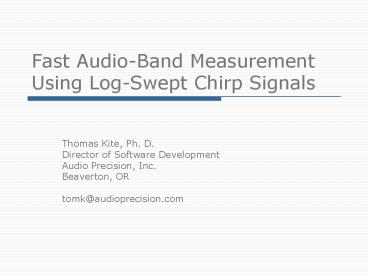Fast Audio-Band Measurement Using Log-Swept Chirp Signals PowerPoint PPT Presentation
1 / 21
Title: Fast Audio-Band Measurement Using Log-Swept Chirp Signals
1
Fast Audio-Band Measurement Using Log-Swept Chirp
Signals
- Thomas Kite, Ph. D.
- Director of Software Development
- Audio Precision, Inc.
- Beaverton, OR
- tomk_at_audioprecision.com
2
Impulse Response (IR)
- Time-domain description of LTI system
- From IR we can derive
- Magnitude vs. frequency
- Phase vs. frequency
- Group delay vs. frequency
- Square wave response vs. time
- Frequency domain resolution depends only on
length of captured IR - No need to wait for device to settle
3
IR Measurement Techniques
- Apply impulse, capture response
- No post-processing needed
- But signal-to-noise ratio (SNR) is very low
- Apply any wideband signal, deconvolve
- Can use music, for instance
- Forward and inverse transforms needed
- SNR depends on energy at each frequency
- Maximum length sequence (MLS)
- Fast Hadamard Transform has low cost
- High SNR due to low crest factor SNR is constant
with frequency (white stimulus)
4
Deriving results from IR
Stimulus
DUT
Processing
Impulse response
Stimulus Processing
Impulse None
Music FFT/IFFT
MLS FHT
Square response
? over t
Magnitude
FFT
Phase
-d?/df
Group delay
5
MLS impulse, frequency response
6
Distortion
- Real-world systems have distortion
- Corrupts impulse response
- Plus, it would be nice to measure it
7
Distortion
- Real-world systems have distortion
- Corrupts impulse response
- Plus, it would be nice to measure it
8
The log-swept chirp stimulus
- Basic form
- where
- T is total length (s)
- , are lower and upper frequencies
- Wideband, low crest factor
9
Chirp characteristics
Constant level in time domain distortion
generation like static sine
Energy (SNR) falls with frequency
10
Measured impulse response
Deconvolved impulse response
11
Measured impulse response
Deconvolved impulse response
12
Measured impulse response
Deconvolved impulse response
Zoomed in 2HD and 3HD products visible
13
Distortion generation
- Stimulus frequency f increases exponentially in
time - DUTs linear response does the same
Time (s) Freq (Hz)
0.0 20
0.1 40
0.2 80
0.3 160
14
Distortion generation
- Stimulus frequency f increases exponentially in
time - DUTs linear response does the same
- Harmonics appear as if advanced in time
Time (s) Freq (Hz) 2HD (Hz)
0.0 20 40
0.1 40 80
0.2 80 160
0.3 160 320
15
What is deconvolution?
Impulse
DUT
Imp. Resp.
16
What is deconvolution?
chirp
Delay ? log(f/f1)
Impulse
Gain ? 1/f
DUT
deconvolution
Delay ? ?log(f/f1)
Imp. Resp.
Gain ? f
- Chirp is a stretched, EQed impulse
- Deconvolution de-EQs and de-stretches
17
Effect on harmonic products
- As with linear response
- De-EQ restores frequency balance
- De-stretch collapses to impulse response
- Time advance separates HD products
At output of DUT
18
Effect on harmonic products
- As with linear response
- De-EQ restores frequency balance
- De-stretch collapses to impulse response
- Time advance separates HD products
After deconvolution
19
Crosstalk measurement
- Chirps separated in time on each channel
- Crosstalk products from other channels advanced
or delayed in impulse response - Works with any stimulus (LTI property)
20
Deriving results from chirp
Chirp
DUT
Deconvolve
Crosstalk
FFT
Extract/replace xtalk
Impulse response
Extract linear IR
Square response
? over t
Magnitude
FFT
Phase
-d?/df
Group delay
Extract harmonics
FFT
Harmonic response
21
Summary
- Speed
- Very short (lt1 second) chirps
- All measurements (14) at same time
- Speed and SNR of measurement can be traded off by
varying length of stimulus - Comparability
- Separation of distortion from linear response
gives uncorrupted impulse response - Linear, distortion, crosstalk measurements all in
close agreement with stepped sine

